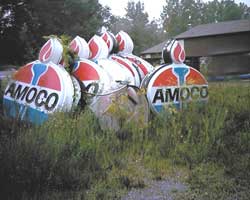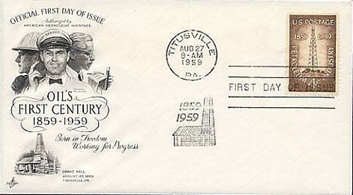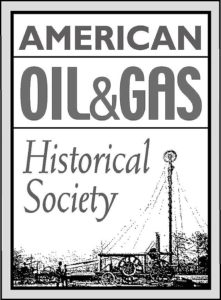August 11, 1891 – Pole Cat Well brings Prosperity to Sistersville –
The discovery well of the Sistersville oilfield brought great wealth to a small West Virginian town on the Ohio River north of Parkersburg and Burning Springs (see Confederates attack Oilfield). “The bringing in of the ‘Pole Cat’ well, which pumped water for a year before it pumped oil, brought in a sudden influx of oil men, drillers, leasers, speculators, followers, floaters, wildcatters, and hangers-on,” a local historian noted.
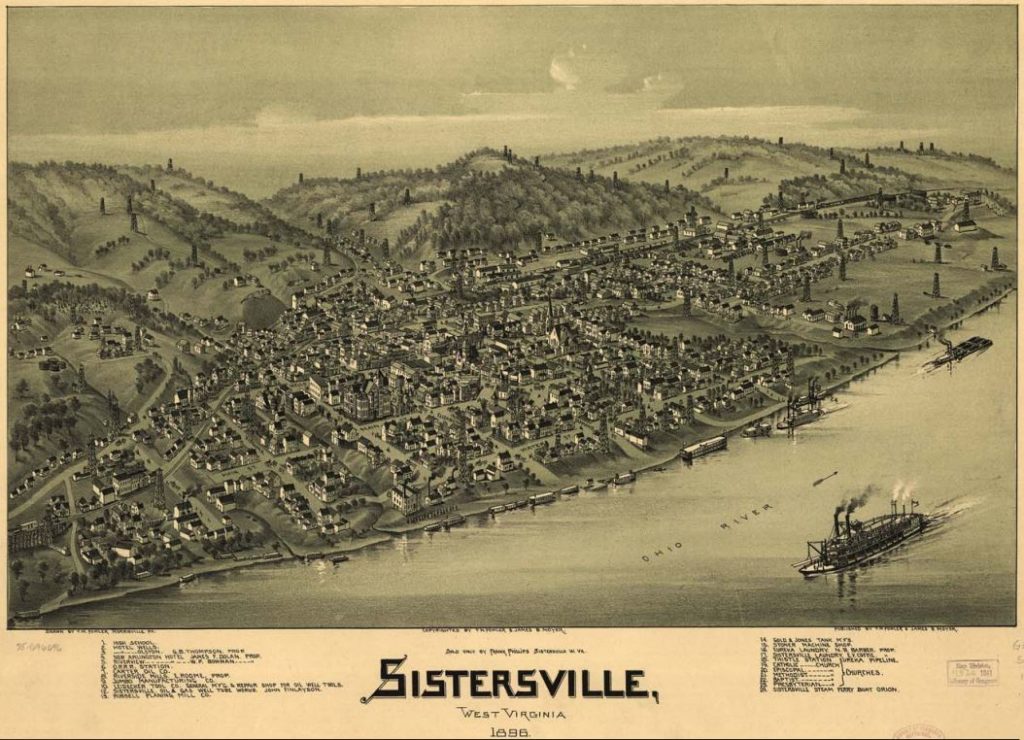
Bird’s-eye-view artist Thaddeus M. Fowler created maps of prospering towns and cities during the Industrial Revolution, including many oil boom towns like his 1896 lithograph of Sistersville, West Virginia. Map courtesy Library of Congress.
The petroleum wealth changed Sistersville from a rural village of 300 people “to a rip-roaring” metropolis of 15,000 people almost overnight. At the height of its petroleum prosperity, cartographic artist Thaddeus M. Fowler of Massachusetts illustrated Sistersville in one of his popular “bird’s eye” maps (see Oil Town “Aero Views”).

2025 West Virginia Oil & Gas Festival Queen Haley Spencer receives her crown from Mia Grace Bailey. Photo courtesy Tyler Star News.
On September 11, 2025, Tyler County’s Ohio River community will host its three-day celebration of the 1891 Pole Cat well (later renamed the Sistersville well). Events at Sistersville City Park will include the Gib Morgan Wrench Throwing Contest and other oilfield-related events hosted by 57th West Virginia Oil and Gas Festival Queen Haley Spencer, crowned in July at the Tyler Consolidated High School Auditorium.
August 11, 1998 – Amoco announces BP merger
Amoco announced plans to merge with London-based British Petroleum Company in a stock swap valued at about $48 billion — then the world’s largest industrial merger. Amoco began in 1889 as John D. Rockefeller’s Standard Oil Company of Indiana. The company officially changed its name to Amoco in 1985.
Finalized on December 31, the combined company, BP Amoco PLC, became 60 percent owned by BP shareholders, marking the transaction as the largest foreign takeover of an American company. Originally named the Anglo-Persian Oil Company in 1935, British Petroleum in 2000 rebranded into BP and announced the closure or renaming of its Amoco stations.
August 12, 1888 – World’s First Auto Road Trip
Thirty-nine-year-old Bertha Benz made history when she became the first person to make a long-distance trip by automobile. Her adventure also included “the first road repairs, the first automotive marketing stunt, the first case of a wife borrowing her husband’s car without asking, and the first violation of intercity highway laws in a motor vehicle,” proclaimed a 2018 article in Wired.
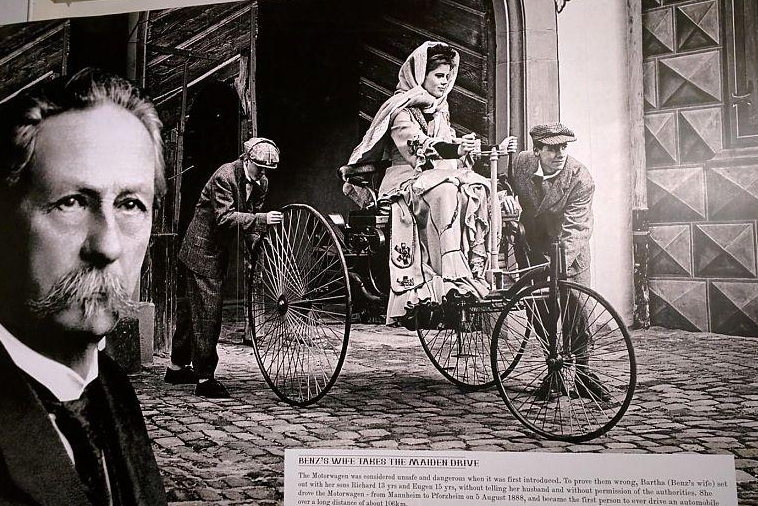
Bertha Benz became the world’s first female automotive pioneer in 1888. Image courtesy Mercedes-Benz Museum.
Bertha drove away in the “Patent Motorwagen” (after leaving a note to her husband) and took their two sons, Eugen, 15, and Richard, 13, to visit her mother in Pforzheim, according to Wired. The trip from Mannheim covered about about 60 miles. “She knew she’d need help, because the 0.88-horsepower engine was a little underpowered, to say the least, and would need to be pushed up some of the steeper hills.”
The 15-hour drive — today the Bertha Benz Memorial Route — helped popularize Karl Benz’s invention. By the end of the century, Mercedes-Benz was the largest car company in the world. The Automotive Hall of Fame inducted Bertha as the first female automotive pioneer in 2016.
Learn more in First Car, First Road Trip.
August 12, 1930 – Kentucky Oil and Gas Producers unite
Eastern Kentucky independent producers joined the Western Kentucky Oil Men’s Association to create a state-wide organization in Frankfort — today’s Kentucky Oil and Gas Association (KOGA). A 1919 oil discovery in Hancock County had launched the petroleum industry in western Kentucky, where commercial amounts of oil had been found as early as 1829 near Burkesville while drilling for brine with a spring-pole (also see Kentucky’s Great American Well).
August 13, 1962 – Norman Rockwell illustrates Oil and Gas Journal
The Oil and Gas Journal promoted itself with an illustration from artist Norman Rockwell in an ad captioned, “Where Oil Men Invest Their Valuable Reading Time.” Rockwell’s renditions of American life brought him popularity through magazines like the Saturday Evening Post, Boy’s Life, and Leslie’s Illustrated Weekly.
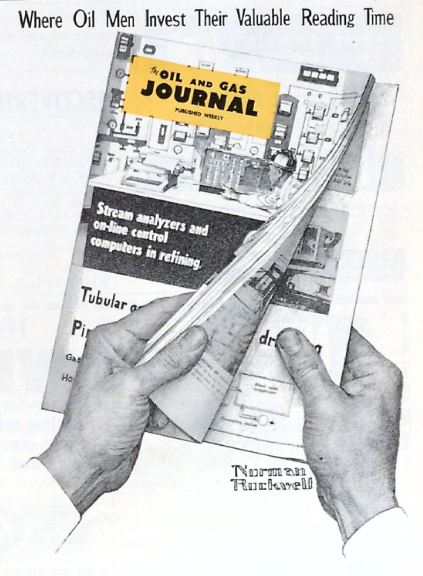
A Norman Rockwell illustration advertised the Oil and Gas Journal, a weekly trade magazine, “Where Oil Men Invest Their Valuable Reading Time.”
In addition to the illustrations for the Oil and Gas Journal, Rockwell in 1959 provided artwork to the American Petroleum Institute (API), which sponsored a U.S. Postal Service “first day of issue” commemorating the 1959 centennial of the birth of the U.S. oil industry (see Centennial Oil Stamp Issue).
The illustration included the slogan “Oil’s First Century 1859-1959, Born in Freedom Working for Progress.”
Rockwell’s drawing depicted “the men of science, the rugged extraction of the crude oil, and ending with your friendly service station attendant,” according to a collector.
August 14, 1986 – California Oil Museum Building listed as National Historic Place
The original headquarters of the Union Oil Company in Santa Paula, California — constructed in 1890 and an oil museum since 1950 — was added to the National Register of Historic Places. Today, the California Oil Museum on 1001 East Main Street includes renovated Union Oil offices on the second floor, above the former Santa Paula Hardware Company and Post Office. Union Oil moved its headquarters to Los Angeles in 1901.
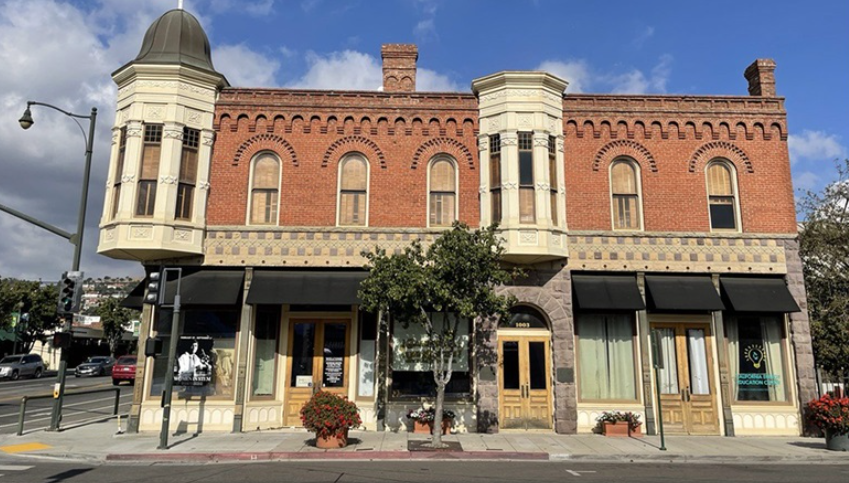
The headquarters of the Union Oil Company of California, founded in Santa Paula in 1890, occupied the second floor; a hardware store and post office were located on the first floor. Chevron donated the building to the city in 2024. Photo courtesy Chevron.
Also designated a Ventura County Cultural Heritage Landmark, the California Oil Museum exhibits working oilfield models, a 19th-century cable-tool drilling rig, Union Oil gas station memorabilia, and an Energy Education Lab with STEM activities for students.
August 15, 1945 – End of World War II Gas Rationing
One day after President Harry Truman announced World War II was over, gasoline rationing ended in America. Food rationing had begun in early 1942 with rubber and gasoline added in December by the Office of Price Administration. Most civilian drivers received a windshield sticker with ration coupons for gasoline, limiting purchases to four gallons a week. A ration book “B” sticker allowed business owners up to eight gallons a week.

World War II gasoline ration stamps and mileage card, Grosse Pointe, Michigan, courtesy Henry Ford Museum.
According to the National World War Two Museum, a “C” sticker was for people with professional occupations, an “M” sticker for motorcycles, and a “T” sticker for truck drivers. A 35 mph speed limit was established for the duration of the war. By the end of 1945, sugar remained the only commodity still being rationed.
August 16, 1861 – World’s Oldest Producing Well
What would become the oldest continuously producing oil well was completed near Oil Creek at Oil City, Pennsylvania. The McClintock No. 1 well initially produced 50 barrels of oil a day from a depth of 620 feet. The well, completed 14 miles from the first U.S. oil discovery two years earlier, has produced continuously at its original depth, according to the Oil Region Alliance.
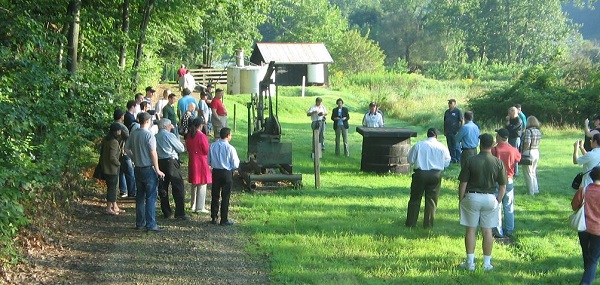
A “Rock Oil Tour” of energy economists from Washington D.C, in 2009 included a stop at the 1861 McClintock well, today pumped a few times a year to supply souvenir bottles sold at the Drake Well Museum in Titusville, Pennsylvania. Photo by Bruce Wells.
Donated by Quaker State in 1995 after the company announced the move of its headquarters from Oil City to Dallas, the McClintock well has pumped monthly to produce up to 10 barrels of oil. Souvenir bottles of the oil today are sold in the Titusville gift shop of the Drake Well Museum.
A historic marker on Route 8 south of Rouseville identifies the record-setting McClintock well, but thousands pass by each year without knowing it’s there. Across the railroad, about 240 yards away, another historic marker commemorates an early oilfield tragedy — the Rouseville 1861 oil well fire.
August 16, 1927 – High-Octane Gas powers Air Race to Hawaii
With a crowd of 50,000 cheering them on, eight monoplanes took off from an airfield in Oakland, California, in an air race over the Pacific. Dole Pineapple Company offered a $25,000 prize to the first plane to reach Honolulu, 2,400 miles away. Three months earlier, Charles Lindbergh had made the first solo trans-Atlantic flight of 1,500 miles.

Several competitors disappeared over the Pacific during the 1927 Dole air race. The winning aircraft today is on display at the Woolaroc Ranch near Bartlesville, Oklahoma.
A new aviation fuel developed by Phillips Petroleum — Nu-Aviation Gasoline — powered the winning “Woolaroc” monoplane for the deadly air race (two of the fuel-heavy planes crashed on takeoff, others were lost in flight). Woolaroc was named for Frank Phillips’ Bartlesville ranch and nature preserve.
Learn more in Flight of the Woolaroc.
August 17, 1785 – “Bituminous Matter” reported at Oil Creek
Two years after the end of the Revolutionary War, oil was reported floating on a creek in northwestern Pennsylvania. “Oil Creek has taken its name from an oil or bituminous matter being found floating on its surface,” noted a report by Gen. William Irvine. “Many cures are attributed to this oil by the natives, and lately by some of the whites, particularly rheumatic pains and old ulcers,” Gen. Irvine wrote.
The discovery confirmed an earlier Army survey reporting that Oil Creek “empties itself into the Allegheny River, issuing from a spring, on the top of which floats an oil, similar to what is called Barbados Tar (see Asphalt Paves the Way), and from which may be collected by one man several gallons in a day.” Decades later, George Bissell studied the seeps, which led to drilling of the first U.S. oil well there in 1859.
August 17, 1915 – End of Hand-Cranked Engines
Charles Kettering of Dayton, Ohio, patented an “engine-starting device,” the first practical electric starter for automobiles. Working as an engineer for Dayton Engineering Laboratories Company (DELCO), Kettering had earlier devised an electric motor to replace hand cranks on cash registers. “The present invention is particularly applicable to automobiles, wherein an engine of the combustion or explosion type is employed, as a means of propulsion,” Kettering noted in his patent.
In addition to his engine-starting patent, in 1921 Kettering and fellow General Motors chemist Thomas Midgley Jr. discovered the gasoline additive tetraethyl lead (see Ethyl Anti-Knock Gas). Cadillac was the first manufacturer to add electric starters to its models. The Ford Model T used a hand crank until 1919; replacing the dangerous method proved popular, especially among women drivers.
_______________________
Recommended Reading: Where it All Began: The story of the people and places where the oil & gas industry began: West Virginia and southeastern Ohio (1994); Bird’s Eye Views: Historic Lithographs of North American Cities
(1998); Bertha Takes a Drive: How the Benz Automobile Changed the World
(2017); Western Pennsylvania’s Oil Heritage
(2008); Winners’ Viewpoints: The Great 1927 Trans-Pacific Dole Race
(2009); Groundbreakers: The Story of Oilfield Technology and the People Who Made it Happen (2015); Sign of the 76: The fabulous life and times of the Union Oil Company of California
(1977); Trek of the Oil Finders: A History of Exploration for Petroleum (1975); Unleaded: How Changing Our Gasoline Changed Everything (2021). Your Amazon purchase benefits the American Oil & Gas Historical Society. As an Amazon Associate, AOGHS earns a commission from qualifying purchases.
_______________________
The American Oil & Gas Historical Society (AOGHS) preserves U.S. petroleum history. Please become an AOGHS annual supporter and help maintain this energy education website and expand historical research. For more information, contact bawells@aoghs.org. © 2025 Bruce A. Wells. All rights reserved.

